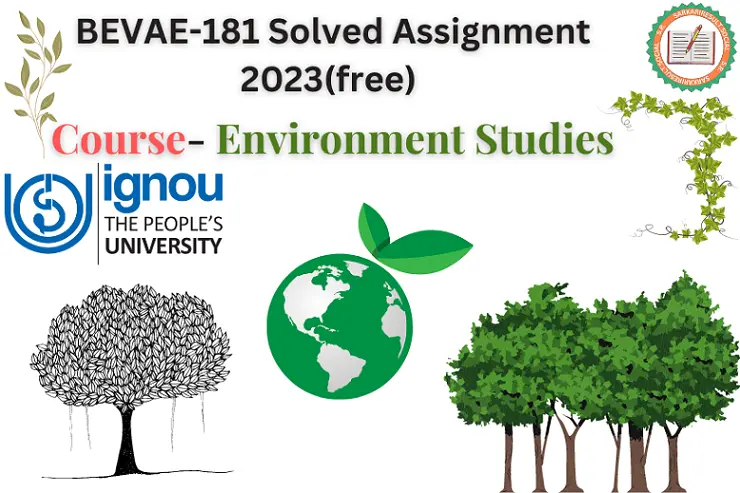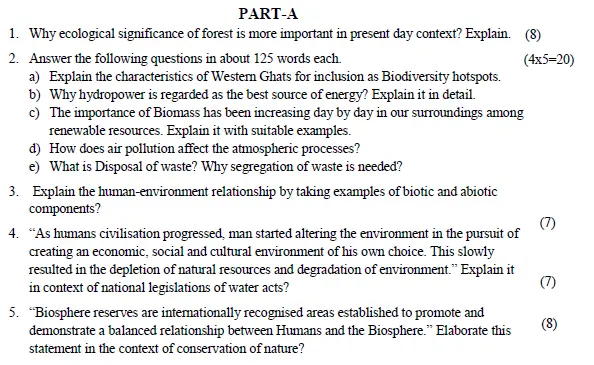Check BEVAE-181 IGNOU Solved Assignment 2023 (free) in top quality

BEVAE-181 IGNOU Solved Assignment 2023 (free)
“Are you interested in learning about the environment studies and how human activities impact the natural world? If so, then you’ll love BEVAE 181, a course offered by IGNOU as part of its Bachelor of Arts program. In this course, you’ll explore topics like climate change, sustainable development, and environmental conservation. As part of your course requirements, you may need to write IGNOU assignments related to the course content. Don’t worry – we’ve got you covered! In this Post, we are providing you IGNOU solved assignment of BEVAE 181.”
Questions and Answers (Solved)
Part A
Q.1 Why ecological significance of forest is more important in present day context? Explain.
Ans. Forests are an important part of our planet’s ecosystem, and their ecological significance is more important than ever before. In the present day context, forests play a crucial role in mitigating climate change, preserving biodiversity, and providing resources for human communities.
Firstly, forests help to mitigate climate change by absorbing and storing carbon dioxide from the atmosphere. This helps to reduce the amount of greenhouse gases in the atmosphere, which is important for maintaining a stable climate.
Forests also help to regulate the water cycle, which is essential for maintaining a healthy ecosystem and ensuring that water is available for human communities.
Secondly, forests are important for preserving biodiversity. They provide habitats for countless species of plants and animals, many of which are endangered or threatened. Protecting forests helps to maintain these habitats and ensure that these species continue to thrive.
Finally, forests provide resources for human communities. They are a source of timber, fuel, and other important materials. They also provide important ecosystem services such as air and water purification, which are essential for human health and well-being.
The conclusion is the ecological significance of forests is more important than ever before. Forests help to mitigate climate change, preserve biodiversity, and provide resources for human communities. Protecting and preserving forests is essential for maintaining a healthy planet and ensuring a sustainable future for all.

2. Answer the following questions in about 125 words.
a) Explain the characteristics of Western Ghats for inclusion as Biodiversity hotspots.
b) Why hydropower is regarded as the best source of energy? Explain it in detail.
c) The importance of Biomass has been increasing day by day in our surroundings among renewable resources. Explain it with suitable examples.
(d) How does air pollution affect the atmospheric processes?
(e) What is Disposal of waste? Why segregation of waste is needed?
Ans (a). The Western Ghats is a mountain range along the western coast of India that is home to a vast array of plant and animal species. It is considered a biodiversity hotspot due to its unique and diverse ecology, with many species found only in this region.
The Western Ghats has a high degree of endemism, meaning that many species are found only in this region and nowhere else in the world. It is also home to many threatened and endangered species.
The region’s complex topography and varied climatic conditions provide a range of microhabitats that support a wide variety of species. These characteristics make the Western Ghats a crucial area for conservation efforts.
Ans (b). Hydropower is considered the best source of energy for several reasons.
Firstly, it is a renewable source of energy, meaning that it can be generated indefinitely without depleting finite resources.
Secondly, hydropower plants are highly efficient, with very little energy loss during the conversion process.
Thirdly, hydropower is a flexible source of energy that can be easily scaled up or down to meet changing energy demands.
Finally, hydropower is a clean source of energy that produces no greenhouse gases or air pollutants, which makes it an environmentally friendly option.
Ans (c). Biomass refers to organic matter such as wood, crops, and waste that can be used as a source of energy. The importance of biomass has been increasing day by day due to its many benefits as a renewable resource.
Biomass is widely available, and it can be used to generate electricity, heat, and transportation fuels. It is also carbon-neutral, meaning that the carbon dioxide released during combustion is offset by the carbon dioxide absorbed during the growth of the biomass.
Some examples of biomass include wood chips, crop residues, and municipal waste. These materials can be converted into biogas, biofuels, and other products that can be used as an alternative to fossil fuels.
Ans (d). Air pollution can have a significant impact on atmospheric processes. Pollutants such as sulfur dioxide and nitrogen oxides can react with other chemicals in the atmosphere to form acid rain, which can have harmful effects on plant and animal life.
Air pollution can also contribute to the formation of smog, which can reduce visibility and harm human health. Pollutants can also affect the climate by absorbing or reflecting sunlight, which can change the Earth’s temperature. Air pollution can also affect the ozone layer, which protects the Earth from harmful ultraviolet radiation.
Ans (e). Disposal of waste refers to the process of getting rid of unwanted materials. Segregation of waste is needed to separate different types of waste materials to facilitate their disposal.
This is important because different types of waste require different methods of disposal. For example, organic waste can be composted to create fertilizer, while hazardous waste must be treated and disposed of carefully to prevent harm to human health and the environment.
Segregation of waste also helps to reduce the amount of waste sent to landfills, which can help to conserve finite resources and reduce the environmental impact of waste disposal. By segregating waste, we can ensure that waste is disposed of in a safe and environmentally friendly manner.
Q.3 Explain the human-environment relationship by taking examples of biotic and abiotic components?
Ans. The relationship between humans and the environment is complex and multifaceted. Humans rely on the environment for resources such as food, water, and shelter, while the environment depends on humans to protect it from harm. This relationship involves both biotic and abiotic components, which interact in various ways.
Biotic components refer to living organisms and their interactions with each other and the environment. For example, humans rely on plants and animals for food, medicine, and other resources. They also interact with these organisms in various ways, such as hunting, fishing, and farming. Humans can have a significant impact on biotic components through activities such as deforestation and pollution, which can harm plant and animal populations.
Abiotic components refer to non-living elements such as air, water, and soil. Humans depend on these resources for survival, but they can also have a significant impact on them.
For example, air pollution from industrial activities can harm human health and damage ecosystems. Water pollution can harm aquatic life and make water unsafe for human consumption. Soil degradation can reduce the productivity of agricultural land and harm ecosystems.
The human-environment relationship is not always negative, however. Humans can also have a positive impact on the environment by engaging in conservation efforts, such as reforestation and wildlife conservation. They can also develop technologies and practices that reduce their impact on the environment, such as renewable energy and sustainable agriculture.
In conclusion, the human-environment relationship is complex and involves both biotic and abiotic components. Humans rely on the environment for resources, but they can also have a significant impact on it. By understanding this relationship and taking steps to reduce their impact on the environment, humans can ensure a sustainable future for themselves and the planet.
Q.4 “As humans civilisation progressed, man started altering the environment in the pursuit of
creating an economic, social and cultural environment of his own choice. This slowly
resulted in the depletion of natural resources and degradation of environment.” Explain it
in context of national legislations of water acts?
Ans. As human civilization progressed, man’s quest for economic, social, and cultural development led to a significant alteration of the environment. This resulted in the depletion of natural resources and degradation of the environment. Water, being one of the most essential natural resources, has been particularly affected by human activities. In response, many countries, including India, have enacted national legislation to regulate water use and management.
In India, the government has enacted several water-related legislations, such as the Water (Prevention and Control of Pollution) Act, 1974, and the Water (Prevention and Control of Pollution) Cess Act, 1977. These acts were passed to control and prevent water pollution caused by industrial, agricultural, and other activities.
The National Water Policy, 2012, emphasizes the need for efficient water use and management to ensure its sustainable availability for all users. The policy aims to promote integrated water resources management, water conservation, and demand management.
In addition to these acts, the government has also established institutions such as the Central Water Commission and the Central Ground Water Board to monitor and manage the country’s water resources.
Despite these efforts, challenges such as water scarcity, pollution, and inefficient use of water resources continue to pose a significant threat to India’s environment and development. Hence, it is essential to implement effective measures to conserve water resources and ensure sustainable development.
In conclusion, the depletion of natural resources and environmental degradation resulting from human activities have led to the enactment of national legislation for water management in India. These laws aim to regulate and control water pollution and promote efficient water use and management. However, challenges persist, and there is a need for continued efforts to ensure the sustainable availability of water resources for all users.
Q.5 “Biosphere reserves are internationally recognised areas established to promote and
demonstrate a balanced relationship between Humans and the Biosphere.” Elaborate this
statement in the context of conservation of nature?
Ans. Biosphere reserves are protected areas of land, sea, and coastal environments designated by the United Nations Educational, Scientific, and Cultural Organization (UNESCO) to conserve the biodiversity and cultural heritage of the area. Biosphere reserves aim to promote and demonstrate a balanced relationship between humans and the environment, with a focus on sustainable development.
These reserves are important for the conservation of nature as they help to protect and preserve the ecosystem’s diversity and integrity. They provide a safe haven for endangered species, prevent soil erosion, and protect the watershed areas. They also serve as research sites for scientists and offer opportunities for environmental education and awareness.
Also see : BGDG 172 IGNOU solved assignment 2023
Biosphere reserves are designed to promote a balanced relationship between humans and the environment, which is essential for the conservation of nature. By creating protected areas that integrate conservation and sustainable development, biosphere reserves can help to ensure that natural resources are used in a responsible and sustainable manner.
In addition, biosphere reserves provide opportunities for local communities to participate in conservation efforts and sustainable development activities. This can help to improve the livelihoods of local people while also promoting the conservation of nature.
Overall, biosphere reserves play a vital role in the conservation of nature by promoting a balanced relationship between humans and the environment. Through conservation and sustainable development efforts, these reserves can help to protect biodiversity and cultural heritage, prevent environmental degradation, and promote the responsible use of natural resources.
Part B
Q.6 Explain the following terms in about 60 words each:
(a) Seed Bank
(b) Incineration
(c) Biological Oxygen Demand
(d) Public Health
Ans (a). Seed Bank: A seed bank is a facility where seeds are stored for the purpose of preserving plant genetic diversity. These seeds can be used to regenerate plant populations that have been lost due to human activities or natural disasters.
Ans (b). Incineration: Incineration is the process of burning waste at high temperatures until it is reduced to ash. It is often used to dispose of hazardous or non-recyclable waste materials.
Ans (c). Biological Oxygen Demand: Biological Oxygen Demand (BOD) is a measure of the amount of oxygen required by microorganisms to break down organic matter in water. It is used to assess water quality and the level of pollution in a water body.
Ans (d). Public Health: Public health is the science and practice of protecting and improving the health of people and communities. It includes a wide range of activities such as disease prevention, health promotion, and environmental health. Public health aims to improve the overall health and wellbeing of populations by addressing the social, economic, and environmental determinants of health.

Q.7 Answer the following questions in about 150 words each.
(a) What is lentic and lotic ecosystem? Explain these two with suitable examples.
(b) What is ecological succession? Explain the types of succession with suitable diagrams.
(c) Explain the biocentrism and ecocentrism in context of human’s attitude towards nature?
(d) Define natural calamities and its types with suitable examples.
Ans (a). Lentic ecosystems refer to standing water bodies such as ponds, lakes, and wetlands. These ecosystems have a relatively calm water surface, which makes them suitable habitats for various aquatic plants and animals.
Lotic ecosystems, on the other hand, refer to flowing water bodies such as rivers, streams, and creeks. These ecosystems have a continuous flow of water, which supports a diverse range of aquatic life, including fish, invertebrates, and algae.
Ans (b). Ecological succession is the process of gradual change in the composition and structure of an ecosystem over time. There are two types of ecological succession: primary and secondary. Primary succession occurs in areas where there is no pre-existing soil, while secondary succession occurs in areas where soil is present but the ecosystem has been disturbed or damaged.
Primary succession begins with the colonization of bare rock by lichens, which over time break down the rock and form soil. This allows the growth of small plants, which eventually become trees and create a forest. Secondary succession, on the other hand, begins with the regeneration of an ecosystem after a disturbance such as a fire or a landslide.
Ans (c). Biocentrism is the belief that all living things have inherent value and should be protected for their own sake. Ecocentrism, on the other hand, is the belief that the entire ecosystem, including non-living elements, has value and should be protected. Biocentrism focuses on the intrinsic value of individual organisms, while ecocentrism focuses on the interconnectedness and interdependence of all elements in an ecosystem.
Both biocentrism and ecocentrism represent a shift away from a human-centric view of nature and emphasize the importance of protecting the environment for its own sake, as well as for the benefit of future generations.
Ans (d). Natural calamities are sudden, severe events that occur in nature and can cause significant damage and loss of life. Some types of natural calamities include earthquakes, hurricanes, tornadoes, floods, landslides, and wildfires.
Earthquakes occur when the earth’s crust shifts, resulting in vibrations or seismic waves that can cause damage to buildings and infrastructure. Hurricanes are large storms that form over the ocean and can cause flooding, high winds, and storm surges when they make landfall.
Tornadoes are violent windstorms that form over land and can cause significant damage to buildings and structures. Floods occur when water levels in rivers or other bodies of water rise rapidly and cause inundation of surrounding areas.
Landslides occur when soil and rock move down a slope, often triggered by heavy rainfall or other environmental factors. Wildfires are large fires that occur in natural areas such as forests or grasslands, often caused by lightning or human activity.
Q.8 Explain the causes of ozone depletion? How do ultraviolet rays affects human health, animals, plants, micro-organisms, water and air quality.
Ans. Ozone depletion is the thinning of the ozone layer in the Earth’s stratosphere, primarily caused by the release of chlorofluorocarbons (CFCs), halons, and other man-made chemicals into the atmosphere. These chemicals can reach the upper atmosphere and react with ozone molecules, breaking them down into oxygen molecules and reducing the amount of ozone in the layer. Some of the main causes of ozone depletion are:
1. Human activity: The use of CFCs in refrigeration, air conditioning, and aerosol sprays, as well as in the manufacture of plastics and other materials, has led to significant ozone depletion.
2. Animals and plants: UV radiation can cause damage to the DNA of plants and animals, leading to mutations and other harmful effects. It can also interfere with the growth and reproduction of plants, reducing crop yields and biodiversity.
3. Micro-organisms: UV radiation can damage the DNA of micro-organisms, reducing their ability to survive and reproduce. This can have significant impacts on ecosystems and food chains.
4. Water quality: UV radiation can break down certain pollutants in water, but it can also increase the growth of harmful bacteria and other micro-organisms, making water unsafe for consumption.
5. Air quality: UV radiation can also contribute to the formation of air pollutants such as ozone and smog, which can have negative impacts on human health and the environment.
In summary, the depletion of the ozone layer can have far-reaching consequences for both human and natural systems. It is important to continue to take steps to reduce the use of ozone-depleting substances and protect the ozone layer for the benefit of present and future generations.
Q.9 “Education for environmental awareness is essential for the younger generation as well as for the older generation.” Explain the statement with suitable examples.
Ans. Environmental awareness is crucial for the conservation of the environment and for the sustainable development of our planet. Education for environmental awareness is essential for both the younger and older generations to understand the impact of human activities on the environment and to adopt practices that promote environmental sustainability.
Younger generations, in particular, need to be educated about environmental issues and solutions, as they will be the ones facing the consequences of environmental degradation in the future.
Environmental education helps them understand the importance of protecting the environment and motivates them to take action to address environmental problems.
For example, schools can teach students about the importance of recycling, reducing waste, and conserving water and energy. They can also promote eco-friendly practices such as using public transportation or biking to school.
However, environmental education is not limited to the younger generation. The older generation also needs to be educated about environmental issues and encouraged to adopt sustainable practices.
This can be done through community outreach programs and public awareness campaigns. For example, workshops and seminars can be organized to educate adults on eco-friendly practices, such as using solar panels, reducing their carbon footprint, and using sustainable materials.
Environmental education also helps people to understand the relationship between humans and the environment. By learning about how human actions impact the environment, people can adopt practices that promote environmental sustainability. This can range from simple actions like turning off the lights when leaving a room to more complex actions like reducing the use of single-use plastics.
In conclusion, education for environmental awareness is essential for both the younger and older generations to promote sustainable development and protect the environment. By educating people about environmental issues and solutions, we can build a more sustainable future for ourselves and for generations to come.
Q.10 “Water Harvesting is one of the effective measures to combat drought.” Explain this statement with suitable arguments.
Ans. Water harvesting is the process of collecting and storing rainwater or surface water runoff for future use. It is an effective measure to combat drought, which is a severe shortage of water that occurs when there is prolonged dry weather and inadequate rainfall.
Water harvesting is a sustainable and eco-friendly way to conserve water resources and reduce the dependence on groundwater and other sources of water.
Water harvesting is an effective way to combat drought because it allows us to conserve water and use it more efficiently. By collecting rainwater and surface runoff, we can store water for future use during periods of drought. This helps to ensure that there is enough water for drinking, agriculture, and other essential uses.
It also helps to reduce soil erosion and improve soil fertility. By capturing rainwater and allowing it to seep into the ground, we can replenish the groundwater table and improve soil moisture levels. This helps to promote the growth of vegetation, which in turn helps to prevent soil erosion and improves soil fertility.
Water harvesting is also cost-effective and easy to implement. Simple techniques such as rooftop rainwater harvesting, contour bunding, and check dams can be used to collect and store rain water. These techniques require minimal investment and can be easily implemented by individuals or communities.
Furthermore, water harvesting is a sustainable and eco-friendly way to conserve water resources. It reduces the need for energy-intensive processes such as pumping and treating water from distant sources, which in turn reduces greenhouse gas emissions and air pollution.
In conclusion, water harvesting is an effective measure to combat drought as it helps to conserve water resources, improve soil fertility, and promote sustainable practices. It is essential that we promote and encourage the practice of water harvesting through education and awareness campaigns, especially in areas prone to drought. By implementing these measures, we can ensure that we have access to clean and safe water for future generations.







